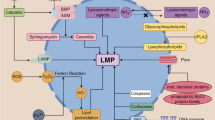Abstract
Accumulating evidence suggests that repeated seizures could induce endoplasmic reticulum (ER) stress. Inositol-requiring protein 1α (IRE1α) is a vital pro-apoptotic molecule in ER stress, but it remains unclear whether the signaling pathway mediated by IRE1α is involved in human temporal lobe epilepsy. In this report, we investigated IRE1α-mediated ER stress pro-apoptotic signaling pathway in resected anterior temporal neocortex from 32 patients with intractable mesial temporal lobe epilepsy by immunofluorescence and western blot analysis. Our results indicate that chronic epilepsy induces ER stress, and IRE1α-mediated ER stress apoptotic signaling pathway is involved in brain damage after repeated seizures, which may provide a new therapeutic target to prevent brain damage caused by epilepsy.





Similar content being viewed by others
References
Pittau F, Bisulli F, Mai R, Fares JE, Vignαli L et al (2009) Prognostic factors in patients with mesial temporal lobe epilepsy. Epilepsia 50:41–44
Bonilha L, Rorden C, Castellano G, Pereira F, Rio PA et al (2004) Voxel-based morphometry reveals gray matter network atrophy in refractory medial temporal lobe epilepsy. Arch Neurol 61:1379–1384
McDonald CR, Hagler DJ, Ahmadi ME, Tecoma E, Iragui V et al (2008) Regional neocortical thinning in mesial temporal lobe epilepsy. Epilepsia 49:794–803
Stefan H, Pauli E (2002) Progressive cognitive decline in epilepsy: an indication of ongoing plasticity. Prog Brain Res 135:409–417
Henshall DC, Simon RP (2005) Epilepsy and apoptosis pathways. J Cereb Blood Flow Metab 25:1557–1572
Paschen W, Frandsen A (2001) Endoplasmic reticulum dysfunction-A common denominator for cell injury in acute and degenerative diseases of the brain? J Neurochem 79:719–725
Xu C, Bailly-Maitre B, Reed JC (2005) Endoplasmic reticulum stress: Cell life and death decisions. J Clin Invest 115:2656–2664
Yamamoto A, Murphy N, Schindler CK, So NK, Stohr S et al (2006) Endoplasmic reticulum stress and apoptosis signaling in human temporal lobe epilepsy. J Neuropathol Exp Neurol 65:217–225
Rao RV, Ellerby HM, Bredesen DE (2004) Coupling endoplasmic reticulum stress to the cell death program. Cell Death Differ 11:372–380
Tirasophon W, Welihinda AA, Kaufman RJ (1998) A stress response pathway from the endoplasmic reticulum to the nucleus requires a novel bifunctional protein kinase/endoribonuclease (Ire1p) in mammalian cells. Genes Dev 12:1812–1824
Lin JH, Li H, Yasumura D, Cohen HR, Zhang C et al (2007) IRE1 signaling affects cell fate during the unfolded protein response. Science 318:944–949
Davis RJ (2000) Signal transduction by the JNK group of MAP kinases. Cell 103:239–252
Henshall DC, Bonislawski DP, Skradski SL, Araki T, Lan JQ et al (2001) Formation of the Apaf-1/cytochrome c complex precedes activation of caspase-9 during seizure-induced neuronal death. Cell Death Differ 8:1169–1181
Boot-Handford RP, Briggs MD (2010) The unfolded protein response and its relevance to connective tissue diseases. Cell Tissue Res 339:197–211
Zheng HC, Takahashi H, Li XH, Hara T, Masuda S et al (2008) Overexpression of GRP78 and GRP94 are markers for aggressive behavior and poor prognosis in gastric carcinomas. Hum Pathol 39:1042–1049
Malhotra JD, Kaufman RJ (2007) The endoplasmic reticulum and the unfolded protein response. Semin Cell Dev Biol 18:716–731
Kitao Y, Ozawa K, Miyazaki M, Tamatani M, Kobayashi T et al (2001) Expression of the endoplasmic reticulum molecular chaperone (ORP150) rescues hippocampal neurons from glutamate toxicity. J Clin Invest 108:1439–1450
Yu Z, Luo H, Fu W, Mattson MP (1999) The endoplasmic reticulum stress-responsive protein GRP78 protects neurons against excitotoxicity and apoptosis: suppression of oxidative stress and stabilization of calcium homeostasis. Exp Neurol 155:302–314
Urano F, Wang X, Bertolotti A, Zhang Y, Chung P et al (2000) Coupling of stress in the ER to activation of JNK protein kinases by transmembrane protein kinase IRE1. Science 287:664–666
Barr RK, Bogoyevitch MA (2001) The c-Jun N-terminal protein kinase family of mitogen-activated protein kinases (JNK MAPKs). Int J Biochem Cell Biol 33:1047–1063
Nishitoh H, Matsuzawa A, Tobiume K, Saegusa K, Takeda K et al (2002) ASK1 is essential for endoplasmic reticulum stress-induced neuronal cell death triggered by expanded polyglutamine repeats. Genes Dev 16:1345–1355
Becker AJ, Gillardon F, Blümcke I, Langendörfer D, Beck H et al (1999) Differential regulation of apoptosis-related genes in resistant and vulnerable subfields of the rat epileptic hippocampus. Mol Brain Res 67:172–176
Acknowledgments
We are grateful to all of the patients who kindly agreed to participate in this study. This work was supported by a grant from the National Natural Science Foundation of China (30870880). We thank Medjaden Bioscience Limited for language editing and copyediting.
Author information
Authors and Affiliations
Corresponding author
Additional information
G.-L. Liu and K.-Y. Wang contributed equally to the work.
Rights and permissions
About this article
Cite this article
Liu, GL., Wang, KY., Guo, H. et al. Inositol-requiring protein 1α signaling pathway is activated in the temporal cortex of patients with mesial temporal lobe epilepsy. Neurol Sci 34, 357–364 (2013). https://doi.org/10.1007/s10072-012-1008-y
Received:
Accepted:
Published:
Issue Date:
DOI: https://doi.org/10.1007/s10072-012-1008-y




